Song Shiqiang from SLKOR Keynote Speech -How AI Empowers New Quality Productive Forces


Compared with developed countries, there is a significant gap in the efficiency of our current productivity. Since the 20th National Congress of the Communist Party of China, "accelerating the development of new quality productivity" has become the focus of work for the country and all sectors of society. High-quality development requires new productivity theories to guide it, and new quality productivity has been formed in practice, demonstrating strong driving and supporting forces for high-quality development. It is necessary for us to summarize and generalize this from a theoretical perspective and apply it to guide development practices. Recently, I, Song Shiqiang, participated in the "8th Thousand-Person Summit of the 2024 Electronic Industry Chain," themed "Empowering New Quality Productivity with Digital Economy," organized by Dajia Yuan Procurement Network and co-sponsored by multiple entities including SLKOR Semiconductor, LCSC, TME, Kinghelm Electronics, and others, and delivered a keynote speech titled "How AI Empowers New Quality Productivity." I hope to share the experiences and profound reflections we have summarized from practical work with everyone!

Ⅰ. New quality productivity and AI are mutually complementary and mutually reinforcing
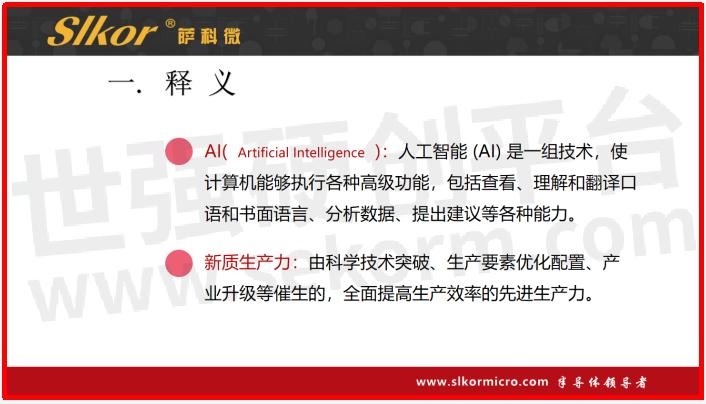
The new productive forces are generated by breakthroughs in science and technology, optimization of production factors, and industrial upgrading, comprehensively improving the efficiency of production. Its rich connotations and wide-ranging implications can be further understood through the three key terms: "new," "quality," and "productive forces."
The "new" aspect primarily refers to "new technologies," "new energy sources," "new driving forces," "new business models," "new types of laborers," and their integration and interchange. "Quality" mainly embodies the requirements of advanced productive force development, emphasizing high efficiency, high quality, and high-level productivity. "Productive forces" denote the specific forms of advanced productive forces, emphasizing the higher stages of human societal productivity development and their role in driving social progress.
Therefore, "new quality productive forces" represent highly efficient, high-quality, high-level productivity, embodying the specific forms of advanced productive forces at the current stage of human societal development. This encompasses various aspects of national economy and people's livelihoods, including advanced manufacturing, new energy vehicles, modern agriculture, the service industry, steel, chemicals, high-end equipment, energy, pharmaceuticals, transportation, and informatization, among others. The semiconductor industry and electronic information industry, where companies like Kinghelm (www.kinghelm.net) and SlkorMicro (www.slkoric.com) operate, naturally fall within this framework.
Developing new quality productive forces requires the establishment of corresponding new production relations, enabling the smooth flow of various high-quality production factors toward the direction of new quality productive forces. Through continuous adjustment, it aims to achieve the most efficient scientific allocation of social total capital. New production relations not only adjust the relationships between people during production processes but also between people and artificial intelligence (AI).
Artificial intelligence (AI) is a set of technologies that enables computers to perform various advanced functions, including viewing, understanding, and translating spoken and written languages, analyzing data, and providing recommendations, among other capabilities.
Ⅱ. Manifestation: The Historical Evolution of Human Societal Development

To empower new quality productive forces in practical work, it is essential to first understand the historical evolution of human societal development. This is because the history of human societal development is a result of continuous advancement in productive forces, improvement in production relations, and subsequently, enhancement in production efficiency. Following the progression of "agricultural society - industrial society - information society," I, Song Shiqiang, will explain in the form of a rhyme:
If the agricultural society relies on "walking for transportation, shouting for communication, shaking for warmth, and dogs for security," then the industrial society is characterized by "multi-story buildings, electric lights, telephones, comfort in all seasons, and reaching for the sky and digging into the earth." Now, the information society is defined by "computational ability, manifestation of desires, clothes and food readily available."
Looking along the timeline, we see the domestication of plants and animals, hunting and gathering transitioning to agriculture in the agricultural society; energy and mineral development leading to increased efficiency in the industrial society; and the advent of the internet and big data bringing convenience and comfort in the information society. These advancements vividly illustrate the significant benefits brought about by the improvement in production efficiency for the transformation and development of human society.
In modern times, the development of productive forces has also brought about "Kondratiev economic cycles." The "Kondratiev cycles," proposed by Russian economist Kondratiev, refer to economic cycles spanning approximately 50-60 years, each marked by a breakthrough technological innovation. The first cycle saw the steam engine driving the industrial revolution, followed by the era of railways, electricity, and heavy engineering, and then the age of petrochemicals and automobiles. Currently, we are in the latter stages of the fourth Kondratiev wave, the era of information technology and the internet, where AI artificial intelligence might be a significant trend. The emergence of large models like ChatGPT and platforms like Sora enables rapid processing of large volumes of image and text data. Additionally, information processing tools such as Kingdee ERP software and Feishu (Lark) contribute to increased efficiency. Feishu's unique "multi-dimensional tables" are particularly effective for OKR (Objectives and Key Results) management, further enhancing labor productivity.
Both I, Song Shiqiang from Kinghelm and SLKOR, believe that AI artificial intelligence technology is our new tool. Its ability to increase efficiency in certain industries and significantly reduce product costs can multiply production efficiency and industrial scale by at least tenfold. This could generate transformative effects similar to the impact of the steam engine on the textile industry or smartphones on the mobile internet industry. Given China's status as the world's factory, it is imperative for China to empower the real economy with artificial intelligence (AI) and pursue high-quality development.
Ⅲ. Development: Major Breakthroughs in the Field of Artificial Intelligence/Digital Era
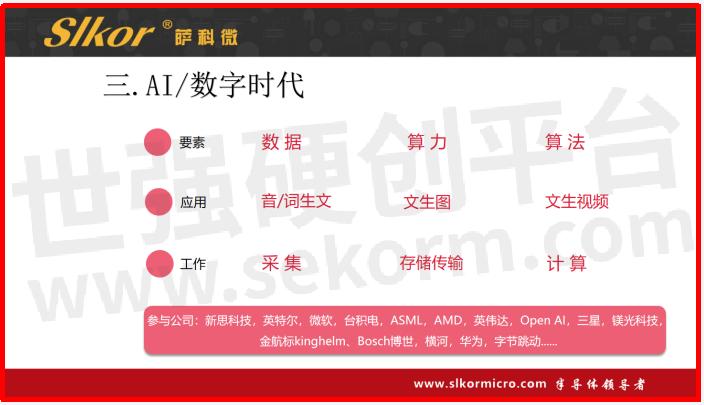
Bill Gates once remarked that artificial intelligence will drive innovation at a pace we haven't imagined before, heralding the formal arrival of the "AI era". Today, the wave of artificial intelligence (AI) is unstoppable: on one hand, from the voice assistants on our smartphones to self-driving cars, from smart homes to medical diagnostics, AI has permeated every aspect of our daily lives; on the other hand, the AI industry is in a fierce competition, with various subsectors emerging and demonstrating remarkable growth potential. AI has gradually become the core driving force behind market development.
Recently, a team from Tsinghua University proposed the third-generation AI's three-space model, connecting the entire perception and cognition system, providing excellent conditions for the development of AI theory. The team also pointed out that since 1956, the development of artificial intelligence has been divided into three stages: the first generation, the second generation, and the third generation. However, so far, there is no well-established theory of artificial intelligence; it mostly consists of models and algorithms, and both the models and algorithms of the first and second generations have many flaws. For example, the first generation of AI utilized the elements of knowledge, algorithms, and computing power, with its core idea being knowledge-driven. The goal was to make machines think like humans through computational models. However, the biggest flaw of this reasoning model is the lack of self-learning ability, making it difficult to learn knowledge from the objective world. All knowledge originates from human indoctrination, so it can never surpass humans. The second generation of AI, stemming from the low tide of the first generation, mainly relies on artificial neural networks, employing data, algorithms, and computing power. Its biggest problem lies in being unsafe, uncontrollable, and difficult to generalize. Therefore, it is imperative to vigorously develop scientifically sound theories of artificial intelligence, upon which safe, controllable, trustworthy, reliable, and scalable AI technologies can be developed.
Currently, the field of artificial intelligence has achieved three breakthroughs: generating semantically coherent text similar to human language, which is coined as "speech/text-to-text generation", "text-to-image generation", and "text-to-video generation" by Kinghelm (www.kinghelm.net) and Slkor (www.slkoric.com) respectively. Among these breakthroughs, semantic coherence is the most important, as it leads to breakthroughs in images, and then inevitably in videos. In this developmental process, the demands for computational resources and hardware will continue to increase, with significant workloads in data collection, storage, transmission, and computation.
The AI wave is unstoppable! In 2020, there were 40 unicorn companies in the world's AI industry with revenues exceeding $1 billion. By 2022, this number increased to 117, and by early 2024, it reached 126. It is evident that with the rapid development of large-scale model technology and the continuous deepening and extensive expansion of AI commercial applications, AI demonstrates strong empowering potential in various industries, successfully opening up new areas of economic growth. Today, the AI industry is in a fierce competition stage, with both overseas tech giants and domestic internet companies actively training and iterating their own model capabilities. Professor Zhou Zucheng from the Department of Electronic Engineering at Tsinghua University told me that computational power is the most important factor in a certain stage of AI development, and Tsinghua University has had exchanges with Newsight Technology in this regard. It serves as the underlying engine for national competition, with a lot of scientific research simulations and analyses, as well as economic operation scheduling such as high-speed rail and high-voltage power grids, requiring advanced computational power whether using large-scale or small-scale models. Just like the entire chip design, simulation, and physical implementation are based on various libraries, most of which currently run on CPUs. Top-tier companies are involved in layout and participation at various nodes of the industrial chain, including Newsight Technology (EDA software), Intel (CPU/GPU), Microsoft (office software), Huawei (Pangu large model), TSMC (high-end chip processing), Kinghelm (www.kinghelm.net, data transmission), ASML (chip equipment), AMD (CPU/GPU), NVIDIA (graphics card), OpenAI (ChatGPT/SORA), Samsung (storage), Micron Technology (storage), Slkor (www.slkoric.com, power module), Bosch (sensor), Yokogawa (sensor), Honeywell (aerospace sensor), ByteDance (Doubao large model), and so on.
Ⅳ.Application Innovation of Slkor's AI Large Model Intelligent Interactive Robot

Currently, successful AI tools derive their power mainly from two "big" aspects: big models and big text. In the era of AI and digital technology, the use of large-scale AI models and applications is thriving. Overseas, large AI models continue to lead the way with outstanding performance and open ecosystems. Meanwhile, domestic large AI models are also catching up and achieving significant breakthroughs. According to incomplete statistics, the number of domestic large AI models has now exceeded 200, covering multiple industry sectors with expanding application scenarios. Notable examples include OpenAI's Chat GPT and Sora, Huawei's Panggu, Baidu's Wenxin Yiyuan, Alibaba's Tongyi Qianwen, iFLYTEK's Xunfei Xinghuo, as well as ByteDance's Yunque and DouBao, all demonstrating performance close to that of GPT-40. The rapid development of open-source and multi-modal models, including BuboGPT (multi-modal), MagicVideo (text-to-video), and Boximator (video editing), have been applied in various fields such as AI glasses/helmets, AI phones/PCs, autonomous driving, and unmanned warfare, indicating that large models will become important assistants in our daily lives.
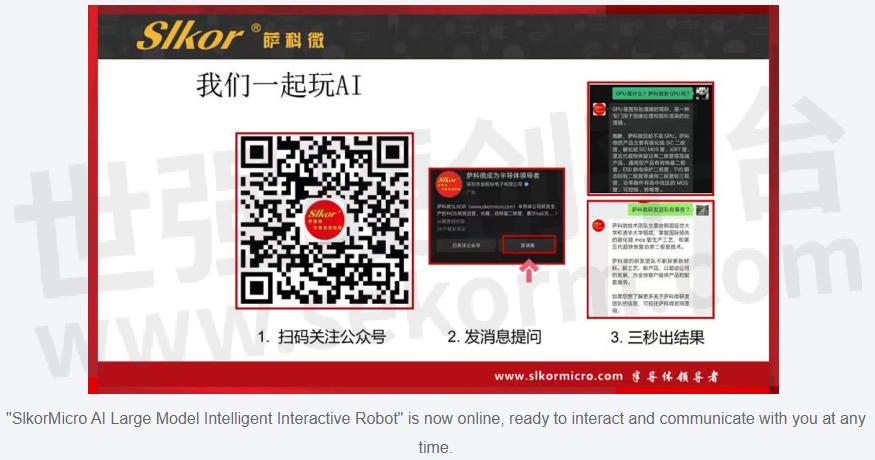
The SlkorMicro AI Large Model, developed by "prodigies" Dr. N and Dr. W, graduates of Tsinghua University, represents a significant advancement in artificial intelligence due to its powerful language generation capabilities, enabling unrestricted dialogue with humans across various domains. Taking the SlkorMicro AI Large Model Intelligent Interactive Robot as an example, its primary advantage lies in providing users with efficient intelligent services anytime, anywhere. Whether during morning coffee, late-night contemplation, or busy work intervals, users can simply engage with the robot by accessing the WeChat official account "SlkorMicro Semiconductor Leader" and typing relevant questions in the dialogue box labeled "Send a message". Questions such as "What type of company is SlkorMicro?", "What products does SlkorMicro offer?", "Who are the founders of SlkorMicro?", and "What are the leading technological features of SlkorMicro in the industry?" will be promptly and accurately answered. Interestingly, SlkorMicro's AI robot responses also exhibit a playful demeanor.
Language models represent a step towards artificial intelligence, gradually evolving towards image processing and associative intelligence, becoming valuable aides in human work and companions in life. However, the journey towards general artificial intelligence remains daunting. Throughout human-machine intelligent chat interactions, the SlkorMicro AI robot effortlessly, intuitively, and efficiently assists users in problem-solving, providing professional service and support. It continually optimizes itself based on user needs and feedback, enhancing service quality, thereby offering users a more personalized and customized service experience. This instantaneous responsiveness significantly reduces user wait times and enhances user experience. With no need for complex operating procedures, users can effortlessly obtain the desired information, making communication more convenient and efficient.

In addition, the SlkorMicro AI robot is also capable of generating male and female spokespersons for "Kinghelm Daily Information" and "Semiconductor TopBuzz," featuring one attractive individual holding Kinghelm and SlkorMicro products from around the world, showcasing distinctiveness and creativity. However, it's important to acknowledge that errors in output content still exist. If we want the AI to be creative, we must allow it to make mistakes. To address this issue, extensive training with a large volume of data is necessary, sometimes requiring the assistance of Tsinghua University's Dr. N and Dr. W to correct errors. It is gratifying to note that the speed of error correction and iteration is rapid. The current style of answering questions already embodies the concise and clear characteristics of SlkorMicro, and the use of tone words is also incorporated.
Ⅴ.Case Study: Deep Integration of the Artificial Intelligence Industry with Vertical Fields
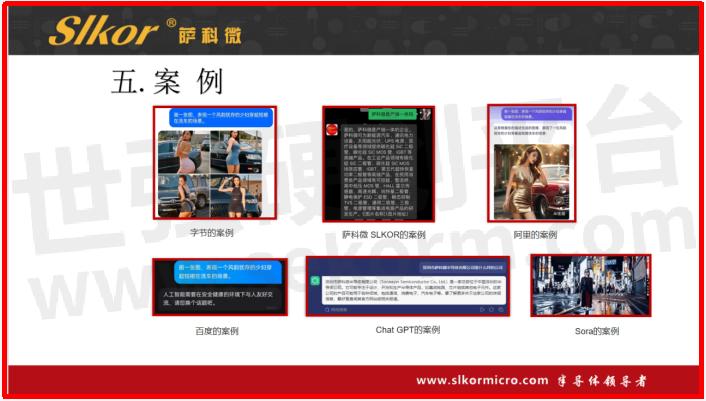
The artificial intelligence industry must undergo deep integration with vertical fields in order to achieve development. For instance, the SlkorMicro AI robot requires extensive and intensive training over a prolonged period, and the ultimate goal of Song Shiqiang and Dr. N is to provide end-to-end services such as internet customer information consultation, material pricing, trade matching, goods delivery arrangements, and customer satisfaction follow-ups. In the future, it will also be integrated with the Kinghelm and Slkor companies' Kingdee ERP systems and the Feishu KOR system, as well as various other applications to boost the rapid development of Kinghelm and Slkor. From this perspective, the SlkorMicro AI robot represents a large model in the vertical subfield of the semiconductor industry, and may potentially influence industrial development in the future.
Ⅵ.Layout Section: The Development and Growing Pains of the Artificial Intelligence Industry
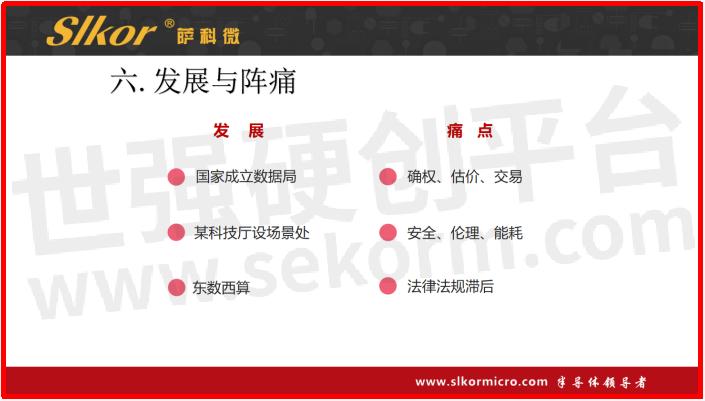
Today, artificial intelligence (AI) has transitioned from the forefront of scientific research to the forefront of practical application. It is actively injecting new vitality into various industries, and new points of economic growth continue to emerge. In order to proactively adapt to new situations and requirements, and to "open up new prospects in changing situations," the National Bureau of Statistics was established on October 25, 2023, in the Science and Technology Department of Anhui Province. Additionally, in order to enable artificial intelligence to play a greater role in economic development, a department for the application of AI scenarios was also established.
The establishment of the National Bureau of Statistics holds significant significance. On one hand, it will coordinate the planning and construction of Digital China, the digital economy, and the digital society at the national level, which will enhance the capacity for "construction" and accelerate the establishment of a data infrastructure system. On the other hand, it will better coordinate the integration, sharing, and utilization of data resources and promote the accelerated innovation and integration of digital technologies such as the internet, big data, cloud computing, artificial intelligence, and blockchain to achieve deep integration of digital technology and the real economy. This is an important measure to seize the opportunities for the development of the digital economy and to create new drivers for economic development.
Furthermore, with the establishment of the department for scenarios and the implementation of the "East Number West Calculation" project by the Science and Technology Department of Anhui Province, it signifies that the development framework of "national top-level planning + enterprise deep cultivation layout" for artificial intelligence has been formed.
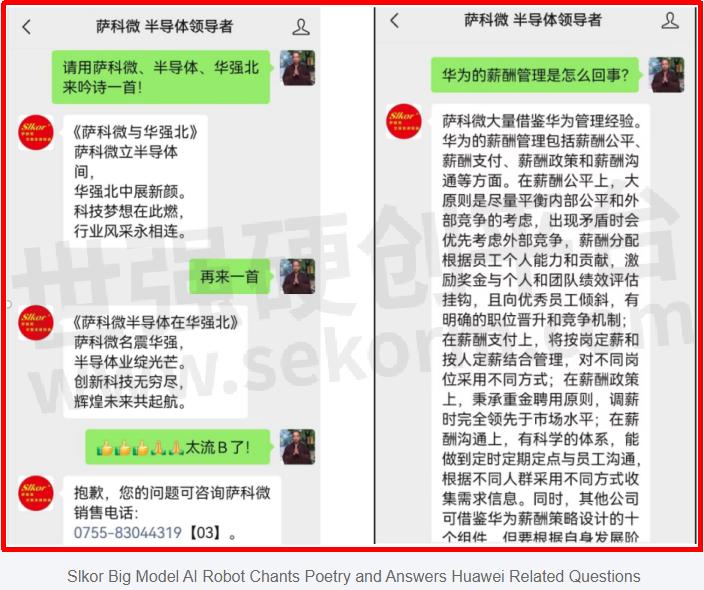
Furthermore, the pain points and challenges in the development of the artificial intelligence (AI) industry serve as accelerators in shaping this development framework. This is because the advancement of artificial intelligence (AI) technology is subject to temporal constraints and entails a series of issues such as rights confirmation, valuation, transactions, security, social ethics, energy consumption, and lagging legislation and regulations. For instance, last year in Hong Kong, an incident involving the fabrication of fraudulent videos resulted in the swindling of over two hundred million in cash, while this year in the Pingshan District of Shenzhen, a criminal case of extortion and blackmail through the manipulation of victim avatars occurred, both leveraging artificial intelligence technology. The resolution of these issues is not an overnight process, but the process and outcomes of their resolution hold milestone significance for the comprehensive promotion of digital China construction, digital economic development, digital society construction, digital infrastructure construction, and data management and utilization.
It is hoped that AI can be applied to various aspects of life and work, making our lives more fulfilling!
- +1 Like
- Add to Favorites
Recommend
- If You Want to Design A Power Module, What Aspects Need to Be Considered?
- What Is A Power Module?
- How to Choose Quality Clearance, and Reliable Power Module Manufacturers?
- What You Need to Consider When Designing a Power Module
- Introduction of China Small Size Power Module Manufacturers
- Power Module Performance Optimization: The Key to Improving Equipment Stability
- Shindengen Launched Compact Power Module MG032 for Large Motor Inverter Circuits
- Power Module: The Heart of Electronic Devices
This document is provided by Sekorm Platform for VIP exclusive service. The copyright is owned by Sekorm. Without authorization, any medias, websites or individual are not allowed to reprint. When authorizing the reprint, the link of www.sekorm.com must be indicated.





























































































































































































































































































































































































































































































































































































































































































































































































































































































